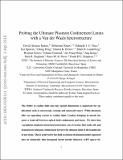Probing the ultimate plasmon confinement limits with a van der Waals heterostructure
Author(s)
Alcaraz Iranzo, David; Nanot, Sébastien; Dias, Eduardo JC; Epstein, Itai; Peng, Cheng; Efetov, Dmitri K; Lundeberg, Mark B; Parret, Romain; Osmond, Johann; Hong, Jin-Yong; Kong, Jing; Englund, Dirk R; Peres, Nuno MR; Koppens, Frank HL; ... Show more Show less
DownloadAccepted version (2.995Mb)
Terms of use
Metadata
Show full item recordAbstract
© 2017 The Authors. The ability to confine light into tiny spatial dimensions is important for applications such as microscopy, sensing, and nanoscale lasers. Although plasmons offer an appealing avenue to confine light, Landau damping in metals imposes a trade-off between optical field confinement and losses. We show that a graphene-insulator-metal heterostructure can overcome that trade-off, and demonstrate plasmon confinement down to the ultimate limit of the length scale of one atom. This is achieved through far-field excitation of plasmon modes squeezed into an atomically thin hexagonal boron nitride dielectric spacer between graphene and metal rods. A theoretical model that takes into account the nonlocal optical response of both graphene and metal is used to describe the results. These ultraconfined plasmonic modes, addressed with far-field light excitation, enable a route to new regimes of ultrastrong light-matter interactions.
Date issued
2018Department
Massachusetts Institute of Technology. Department of Electrical Engineering and Computer ScienceJournal
Science
Publisher
American Association for the Advancement of Science (AAAS)